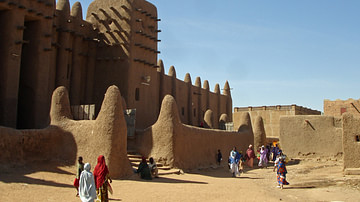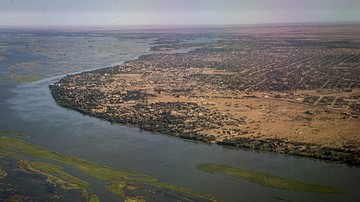
Mansa Musa I was the ruler of the Mali Empire in West Africa from 1312 to 1337. Controlling territories rich in gold and copper, and monopolising trade between the north and interior of the continent, Mali grew extremely wealthy. Mansa Musa was said to have spent so much gold in Cairo that the value of bullion crashed by 20%.
A Muslim like his royal predecessors, Mansa Musa brought back architects and scholars from his pilgrimage to Mecca who would build mosques and universities that made such cities as Timbuktu internationally famous. Mansa Musa's 1324 stopover in Cairo, though, would spread Mali's fame even further and on to Europe where tall tales of this king's fabulous wealth in gold began to stir the interest of traders and explorers.
The Mali Empire
The Mali Empire (1240-1645), the largest and richest empire yet seen in West Africa, was founded by Sundiata Keita (aka Sunjaata, r. 1230-1255). The Mali capital was Niani, and the most important trading city was Timbuktu near the River Niger and located where major waterways and land routes converged. Immense wealth was gained from acting as a trade hub between the interior and southern coast of West Africa and North of Africa across the Sahara desert's caravan routes. Salt was a major commodity traded from the north while from the south came gold and ivory. The empire eventually included Ghana, Walata, Tadmekka, and the kingdom of Songhai and ultimately stretched all the way to the Atlantic coast. Indigenous rulers adopted Islam from their contact with Arab merchants, and the Mali Empire would thus play a significant part in the spread of Islam across West Africa. Locals, or at least urban ones, were converted, which created communities that then attracted Muslim clerics from the north, strengthening the religion's grip on the region. Local leaders would even perform pilgrimages to the Islamic holy sites like Mecca, including their greatest ever ruler, Mansa Musa.
Mansa Musa & the Empire
Mansa Kanku Musa took power in 1312 and inherited an already prosperous Mali kingdom; he would reign until 1337. Mansa was the traditional Mali title meaning 'king' and Musa was the grand nephew of the founder Sundiata Keita. Mansa Musa gained the throne after his predecessor, Mansa Abu Bakr II, sailed out into the Atlantic with a large fleet of ships and was never seen again. Exploration's loss was Mali's gain, and Mansa Musa, nominated to rule while Abu Bakr II satisfied his curiosity as to what lay over the horizon, would become one of the greatest rulers in the entire history of Africa.
With an army numbering around 100,000 men, including an armoured cavalry corps of 10,000 horses, and with the talented general Saran Mandian, Mansa Musa was able to extend and maintain Mali's vast empire, doubling its territory and making it second in size only to that of the Mongol Empire at the time. Mali controlled lands up to the Gambia and lower Senegal in the west; in the north, tribes were subdued along the whole length of the Western Sahara border region; in the east, control spread up to Gao on the Niger River and, to the south, the Bure region and the forests of what became known as the Gold Coast came under Mali oversight. This latter region was left semi-independent because gold production had always been much higher when more autonomy was granted there. The Mali Empire would never control such large territories or natural resources under any of its subsequent rulers.
To better govern this vast expanse of land containing a multitude of tribes and ethnic groups, Mansa Musa divided his empire into provinces with each one ruled by a governor (farba) appointed personally by him. The administration was further improved with greater records kept and sent to the centralised government offices at Niani. The wealth of the state increased thanks to taxes on trade, the Mali-controlled copper and gold mines, and the imposition of tribute from conquered tribes. Mansa Musa thus became extremely wealthy, perhaps even the richest person in history.
Mansa Musa in Cairo
Mansa Musa, like many other devout Mali rulers before and after, set off for a pilgrimage to Mecca in 1324, but when he arrived in Cairo in July of that year en route, he caused an absolute sensation. The Mali ruler's camel caravan had crossed the Sahara and when he arrived in Egypt, even the Sultan was astounded by the wealth this West African king had brought with him. In some accounts, each of 100 camels carried 135 kilos or 300 pounds of gold dust while 500 slaves each brandished a 2.7 kilo (6 pounds) gold staff. In addition, there were hundreds of other camels loaded down with foodstuffs and textiles, horse riders waving the huge red and gold banners of the king, and an impressive human entourage of servants and officials that numbered in the tens of thousands. In an extreme gesture of largesse, Mansa Musa would give away so much gold and his entourage spend so much shopping in the markets of the city that the value of gold dinar in Cairo crashed by 20% (in relation to the silver dirham); it would take 12 years for the flooded gold market to recover.
The merchants of Egypt, in particular, were delighted with all these naive tourists suddenly milling about their markets and they took full advantage, raising their prices and relieving the shoppers of their gold at any opportunity. Indeed, Mansa Musa and his people so overspent that they left the city in debt, a factor which contributed to later Egyptian investment within the Mali Empire so that the merchants could recoup some of the value of the goods they had given on credit.
The king of Mali had given 50,000 gold dinars to the sultan of Egypt merely as a first-meeting gesture. The sultan was rather ignoble in return and insisted that Mansa Musa kiss the ground in homage. In all other respects, though, this ruler from Africa's mysterious interior was treated like the royalty he was, given a palace for his three-month stay, and lauded wherever he went. The Arab historian Al-Makrizi (1364-1442) gives the following description of the king of Mali:
He was a young man with a brown skin, a pleasant face and good figure…His gifts amazed the eye with their beauty and splendour.
(quoted in Zerbo, 59)
An indication of the impression Mansa Musa had made is that news of his Cairo visit eventually reached Europe. In Spain, a mapmaker was inspired to create Europe's first detailed map of West Africa. Created c. 1375, the map, part of the Catalan Atlas, has Mansa Musa sitting regally on a throne, wearing an impressive gold crown, and holding a golden staff in one hand and, somewhat gleefully, a huge nugget or orb of gold in the other. It was such tales of gold that would inspire later European explorers to brave disease, warlike tribes, and inhospitable terrain to find the fabled riches of Timbuktu, the golden city of the desert that nobody quite knew where to place on the map even in the 18th century.
After Cairo, Mansa Musa would travel on to Arabia where he purchased land and houses so that pilgrims from Mali who followed in his footsteps might have a place to stay. The king was inspired by the holy sites he saw there and on his return to Mali, he built a dazzling audience chamber at Niani and mosques at Gao and Timbuktu. These included the 'great mosque' in the latter city, also known as Djinguereber or Jingereber. The buildings were designed by the famous architect Ishak al-Tuedjin (d. 1346 and also a noted poet) from Andalusian Granada, who had been enticed from Cairo following Mansa Musa's visit there - the inducement included 200 kilos (440 pounds) of gold, slaves, and a swathe of land along the Niger River. The mosque was completed by 1330, and al-Tuedjin lived the rest of his life in Mali. A royal palace or madugu was built in the capital city and Timbuktu, along with fortification walls to protect the latter city against raids by the Tuareg, the nomads of the southern Sahara. Due to the lack of stone in the region, Mali buildings were typically constructed using beaten earth (banco) reinforced with wood which often sticks out in beams from the exterior surfaces.
Mansa Musa was also inspired by the universities he had seen on his pilgrimage, and he brought back to Mali both books and scholars. The king greatly encouraged Islamic learning, especially at Timbuktu, which, with its mosques, universities, and many Koranic schools, became not only the holiest city in the Sudan region of Western Africa but also an internationally famous centre of culture and religious study. In addition, Mansa Musa sent native religious scholars to Fez in Morocco to learn what they could and then return to Mali as teachers. With these education links there were, too, diplomatic ones with Arab states, as well as the flow of investment into Mali, as Egyptian traders and others sought access to the lucrative movement of goods across West Africa.
Death & Successors
Mansa Musa was succeeded first by his son Mansa Maghan I (r. 1337-1341), who had also ruled as regent while his father had been on his famous pilgrimage, and then by his brother Mansa Sulayman (c. 1341-1360). That Maghan's reign lasted only four years and his place was taken by his uncle would suggest foul play but concrete evidence is lacking. Mansa Sulayman did continue his brother's promotion of Islam, and the Mali Empire would prosper for another century or so before new trade routes were opened up by the Portuguese. The discovery of new goldfields and access to the southern coast of West Africa meant that by the mid-15th century Mali no longer monopolised trade in the region. Significantly, the Mali mansas were also guilty of fighting amongst themselves as civil wars wracked the empire. As a consequence, first, the Tuareg attacked Mali cities like Timbuktu, and then the burgeoning Songhai kingdom, ruled by King Sunni Ali (r. 1464-1492), definitively took over most of the Mali territories in the 1460s.








